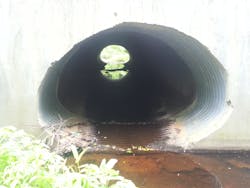VDOT repairs culvert, avoids costly roadway rehabilitation with GCCM solution
As a result of periodic culvert inspections, the Virginia Department of Transportation (VDOT) identified an existing triple-barrel steel-plate culvert south of Richmond, Va., as requiring a repair. Since the roadway above the existing culvert had just been repaved and new guardrail had been installed, VDOT wanted to avoid total replacement.
The worst corrosion of the steel was in the invert. In addition, the roadway had been widened in the past and newer pipe was added outside of the original culvert. Corrosion of the culvert was seen at the flow line and the shape appeared to be in its original geometry. The roadway embankment was stable and there were no signs of soil movement or cracking.
VDOT wanted to avoid more expensive repair options including various types of lining systems that are available, such as topical invert coatings and relining systems. Due to the access limitations, the VDOT maintenance crew selected Concrete Cloth geosynthetic cementitious composite mats (GCCMs) from Milliken Infrastructure Solutions (MIS). Concrete Cloth GCCM is a three-dimensional flexible concrete impregnated fabric that hardens on hydration to form a durable, waterproof and fire-resistant concrete layer.
Approximately 500 sq ft of CC13, MIS’ thickest GCCM solution, was specified for this project. The product fit perfectly with the repair objectives, as it is frequently used for flows with high levels of debris, high flow conditions or regions prone to impacts.
Strips of the Concrete Cloth GCCM were lowered from the roadway above to the berm just outside the inlet of the culvert using an excavator. Installing the Concrete Cloth GCCM perpendicular to the direction of flow allowed the maintenance crew to carry smaller pieces rather than installing long pieces parallel to the flow. This method led to a rapid installation, and the un-hydrated material was installed in less than a day.
VDOT then had the choice of hydrating the Concrete Cloth GCCM by either pumping water from the nearby stream or bringing a water truck to the site. Water from streams was diverted through another barrel and Concrete Cloth was installed in the dry. A power actuated fastening system was chosen to secure the Concrete Cloth to the existing plate structure because of its thickness.
Because a Concrete Cloth repair was merely a fraction of more expensive repair methods, it was initially chosen to line a single barrel of the culvert. After some time, its performance was then evaluated to determine if it was a viable alternative to line the flow line of the other two barrels of this triple-barrel culvert. The product’s ease-of-installation and durability were among the most important factors to the success of the repair, which has extended the life of the culvert by a minimum of 10 years.
